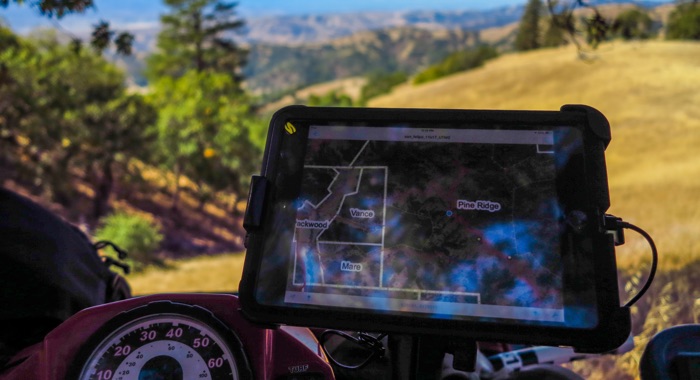A third of California is privately-owned forestland, woodland or grassland. From redwood forests on the north coast to oak savannas in the foothills, these “working wildlands” harbor native plants and animals and natural resources that shape California’s cultural and economic identity. The agricultural goods produced in these landscapes feed into a global market – from beef and dairy to building materials. Rangelands also help recharge groundwater. Healthy forests enhance water quality.
Harvest practices that are unsustainable, however, or conversion of these landscapes to more intensive land uses, can degrade habitats and reduce the flow of important benefits to people.
Working wildlands are what keep California stitched together ecologically. Their continued economic viability is key to the persistence of the ecological benefits they provide. Conservancy scientists work to figure out how to protect and enhance the function of these landscapes – as a critical network for nature.

Daniel Porter, Robert Longcor
Forests of the Sierra Nevada and across the western U.S. are under unprecedented threat from catastrophic wildfire, insect outbreaks, and drought. In this briefing paper, which was developed as a…M. Florencia Miguel, H. Scott Butterfield, Christopher J. Lortie
This meta-analysis provides a global synthesis of the which restoration practices – active vs. passive – are most successful at restoring plants, animals, and other ecosystem functions to…Ethan Inlander, Katie Andrews, Contributors: Jennifer Chin, Sue Pollock, Mike McFadden, Scott Hardage, Scott Butterfield, Tod Rubin
With this publication, TNC in California marks a major shift in its approach to conservation easement monitoring. At the crossroads of conservation, stewardship and technology lies remote property…Gavin M. Jones, H. Anu Kramer, Sheila A. Whitmore, William J. Berigan, Douglas J. Tempel, Connor M. Wood, Brendan K. Hobart, Tedward Erker, Fidelis A. Atuo, Nicole F. Pietrunti, Rodd Kelsey, R. J. Gutierrez, M. Zachariah Peery
This study examined spotted owl habitat selection after the King Fire in California using satellite tracking of 26 different owls . The authors found that whether severe fire was "good" or "bad" for…Stephanie Dashiell, Mark Buckley, Dustin Mulvaney
In an effort to address climate change, California enacted a clean energy energy standard that is driving a market for significant amounts of renewable energy. To explore the economic benefits of…Kristin B Byrd, Pelayo Alvarez, Benjamin Sleeter, Lorraine Flint, Alan Flint, Richard Cameron, Jeffrey Creque
Management of protected lands may enhance ecosystem services that conservation programs were designed to protect. Practices that build soil organic matter on agricultural lands also increase soil…Gorm E. Shackelford, Rodd Kelsey, Lynn V. Dicks
As California and other major agricultural regions around the world tackle the challenge of increasing the sustainability of agriculture to improve environmental health, cover crops are increasingly…Grace C. Wu, Emily Leslie, Douglas Allen, Oluwafemi Sawyerr, D. Richard Cameron, Erica Brand, Brian Cohen, Marcela Ochoa, Arne Olson
California has ambitious climate and energy policies that call for the development of significant amounts of new zero-carbon energy by midcentury. The Power of Place study looks at multiple pathways…M. Prunicki, R. Kelsey, J. Lee, Z. Xiaoying, H. Smith, F. Haddad, J. Wu, K. Nadeau
Annika T. H. Keeley, Galli Basson, D. Richard Cameron, Nicole E. Heller, Patrick R. Huber, Carrie A. Schloss, James H. Thorne, Adina M. Merenlender
Connectivity conservation must move more rapidly from planning to implementation. We provide an evidence‐based solution composed of key elements for successful on‐the‐ground…W. David Shuford, Matthew E. Reiter, Kristin A. Sesser, Catherine M. Hickey, Gregory H. Golet
Agricultural intensification has been a major factor in the loss of global biodiversity. Even so, agricultural landscapes provide important habitat for many bird species, particularly in the Central…Annika T H Keeley, David D Ackerly, D Richard Cameron, Nicole E Heller, Patrick R Huber, Carrie A Schloss, James H Thorne, Adina M Merenlender
As climate change impacts wildlife and plants, species may need to access new habitats. Various approaches exist to plan to climate-driven habitat connectivity needs. We summarize the literature of…Kelly Gravuer, Sasha Gennet, Heather L. Throop
Interest in land application of organic amendments—such as biosolids, composts, and manures—is growing among landowners, managers, and climate policy leaders due to their potential to…David C. Marvin, Dick Cameron, Erik Nelson, Andrew Plantinga, Justin Breck, Gokce Sencan, Michelle Passero
Ecosystems can increase carbon storage under alternative management techniques and land use patterns. But the magnitude, timing, and spatial heterogeneity is uncertain. Assessing the potential and…Kristen Sesser, Monica Iglecia, Matthew Reiter, Khara Strum, Catherine Hickey, Rodd Kelsey, Daniel Skalos
Over 50% of waterbird habitat in the Central Valley of California is provided by flooded agricultural land. Each year non-breeding waterbird habitat decreases in the late winter as flooded…Walter N. Heady, Brian S. Cohen, Mary G. Gleason, Joshua N. Morris, Sarah G. Newkirk, Kirk R. Klausmeyer, Hilary R. Walecka, Elizabeth Gagneron
Sea level rise presents a new challenge to coastal conservation. The authors quantified and mapped the vulnerability of habitats, imperiled species, and conservation lands to sea level rise throughout…Matthew E. Reiter, Nathan K. Elliott, Dennis Jongsomjit, Gregory H. Golet, Mark D. Reynolds
In the Central Valley of California, with 90% of the historic wetlands gone, waterbirds depend upon managed wetlands and seasonally flooded agriculture to meet their habitat needs. The 2013-2015…D. Richard Cameron, David C. Marvin, Jonathan M. Remucal, Michelle C. Passero
Combatting climate change will require using all available tools, especially those that contribute to other societal and economic goals, such as natural resource protection and energy security.…